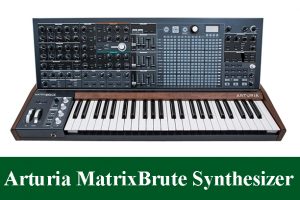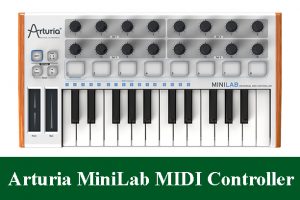Arturia MicroBrute Analog Synthesizer Review (Updated)
Arturia MicroBrute : For a long time, Arturia was known as a boutique programming organization that spent significant time in making quality programming emulations of both exemplary and present day synthesizers. This was the organization’s meat and potatoes for a long time, and from various perspectives, regardless it is. Be that as it may, with the dispatch of the MiniBrute in 2012, Arturia made its first triumphant strides out into the wide universe of equipment blend.
Presently, with the entry of the MicroBrute, we have more options than any other time in recent memory from Arturia regarding equipment synthesizers. The question, obviously, is basic: can the MicroBrute satisfy the heritage of it’s more established sibling?
Overview
Upon first look, those acquainted with the MiniBrute will quickly perceive a few design likenesses inside the MicroBrute.
The principle distinction, obviously, is that the MicroBrute is generally a large portion of the impression of the MiniBrute, and features two octaves worth of smaller than usual keys to oblige the size reduction. The equipment synth utilizes a solitary oscillator design, with a multi-waveform setup that takes into consideration the blending of various likewise pitched sawtooth, square and triangle waveforms together. The ever-mainstream Roland SH-101 utilized this setup also, and to extraordinary achievement.
I don’t get this’ meaning for the MicroBrute, however?
Clearly, only having a solitary oscillator in principle restrains how “monstrous” you can make the sound, since you aren’t joining various distinctive detuned oscillators to make one fat, substantial sound. None of this is to state that the MicroBrute doesn’t pack a punch; to the contrary, really. The MicroBrute features some extremely amazing tech in the engine, for example, a vigorous capacity to alter the idea of the sounds originating from the oscillator itself.
What the MicroBrute Offers
The general design of the MicroBrute is to a great degree functional, and puts the majority of the basic functions available to you. There’s no menu plunging here, and the greater part of the best sounds you’re ready to think of while utilizing this thing will originate from being available to experimentation at consistently (numerous equipment synthesizers).
In the upper left section of the synth control surface, you’ll discover the oscillator controls. From here, you can alter the properties of the sounds being played, and additionally the amount of venture waveforms mixed into every individual sound. To one side, you have the channel module, which enables you to alter and try different things with different filtration settings so as to accomplish an increasingly mind boggling and textural sound.
Past this on the extreme right hand side of the synth is the mod framework section. Here, you can utilize the fix links to control different parameters and impacts on the sounds. This isn’t exactly as profound as other, progressively complex synthesizers and modules, yet it is still positively an appreciated addition to the gathering.
The base section of the control surface is home to alternate functions of the synth, for example, the LFO settings, the envelope, and the sequencer. Every one of these distinctive functions is critical to accomplishing a quality sound with the synthesizer keyboard, and in the event that you would like to genuinely ace this thing, you’ll have to invest energy messing around with every one of them.
Obviously, none of this genuinely matters if the smaller than usual keys are too little to even think about having any fun playing on. We realize this is dependably a fervently discussed subject, so for this next section, how about we investigate how it feels to really play the Arturia MicroBrute.
Playing the MicroBrute
Taking a seat out of the blue with a smaller than expected keyboard can be overwhelming, particularly for built up keyboardists (don’t kick me off on doing as such as a piano player). For some, however, these keyboards are standard charge these days, as synthesizers and MIDI controllers have been making utilization of smaller than usual keys for a long time now.
The two octave keybed here feels shockingly playable, however there’s a lot of development to the plastic shaped keys, both vertically and horizontally. This isn’t really a major issue, in any event not for most, but rather it’s an irritation and many will discover it diverting, best case scenario, execution blocking at the very least.
It is extremely common for these kinds of keys to experience the ill effects of soundness issues, so it isn’t actually reasonable for single the MicroBrute out in such manner, yet all the equivalent, we certainly wish the keybed was more generous.
The keys themselves have all the earmarks of being neither speed delicate nor aftertouch-detecting. For some, that implies playing this thing is a non-starter, and for those players, a different MIDI keyboard controller is suggested.
Connectivity
To the extent connections go, the MircroBrute has pretty much all that you’d ever require in an equipment synth. There’s a pitch and door out, an entryway in, a line out for sound, a stereo headphone jack, a solitary info jack, and a MIDI in. At last, there’s a USB B MIDI connection for interfacing with a PC or cell phone.
One champion feature identifying with the MIDI connections is that, extraordinarily, the MIDI connection can send pitch curve, modulation, and affectability/speed information, all polyphonically (the synth itself is monophonic, obviously). This is something that we wish more synthesizers would incorporate, paying little mind to how “specialty” of a feature it may be. It’s imperative to take note of that there is in certainty a CV connection for interfacing with different synthesizers and sequencers, and that it is situated on the front board with the patches on the extreme right.
Sounds
One thing ought to be clarified preceding we jump into the sounds this thing is equipped for making; the “Animal” in the title isn’t simply showcasing publicity. This isn’t the synth for your wonderful, surrounding keys and crystalline leads; this thing is down and filthy, and the sounds that it produces mirrors that in full confidence.
One reaction of this personality that we didn’t love was the way that making what ought to be basic sounds, similar to a PWM sound or an old simple ARP, is shockingly troublesome. The MircroBrute (from various perspectives, similar to the MiniBrute) is getting it done at whatever point you don’t battle against its current, rather releasing it where it needs to amid the design stage.
Indeed, even in the wake of playing around for only a couple of minutes, we had the capacity to make a really remarkable, throaty bass sound that was not normal for pretty much anything I’ve at any point heard previously, particularly at an item in this cost go.
This equitable demonstrates how staggeringly profound you can run with the apparently oversimplified controls and blend motor inside the MicroBrute, and toward the finish of our session, we were left needing more.
One thing that we didn’t personally involvement, however that numerous reviewers have noted, is that the MicroBrute takes around 15 minutes to heat up in the wake of being presented to colder temperatures. Clients have noticed that it takes at any rate this long for the instrument to bolt into key, and that there are a few distinctive following mistakes that are common ideal on startup.
Along these lines, since we’ve investigated the abilities of the MicroBrute, we should investigate some comparable items out there available as of now.
Competition
Arturia is still generally new to the equipment synthesizer advertise, and in that capacity, they confront solid competition from a few entrenched brands who have been making keyboard synthesizers far longer than the French programming organization has. In this section, we will investigate a couple of comparative models to the MicroBrute, beginning with the elder sibling himself, the MiniBrute.
Pros
- Extraordinary feature set at the cost.
- Extraordinary quality sounds in spite of the single oscillator.
- Extraordinary look and feel in general.
Cons
- Smaller than expected keys.
- That’s all anyone needs to know.
The Bottom Line
The Arturia MicroBrute is an incredible and extraordinary equipment synthesizer that hits all the correct notes. It’s moderate, flexible, or more all else, an impact to play.
Conclusion
All things considered, the Arturia MicroBrute, similar to it’s more established sibling, is a power to be reckoned with in the realm of equipment synthesizers. Arturia has really put a great deal into their equipment endeavors as far back as 2012, and it appears through in their whole design reasoning. The combination of awesome altering features, a profound yet shortsighted amalgamation motor, and a natural and fun sequencer makes for an incredible bundle that is certain to shock and enjoyment keyboard players all things considered and foundations.
That being stated, we surely imagine this is a touch of unit best enjoyed by someone who definitely realizes somewhat about what they’re doing. The absence of a menu framework, combined with some beautiful inside and out altering parameters, implies that there’s somewhat of a precarious expectation to learn and adapt here, as there is with numerous equipment synthesizers.





